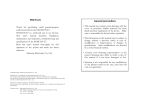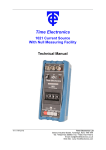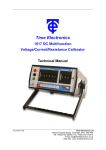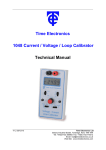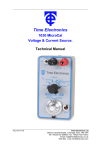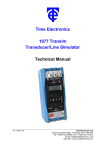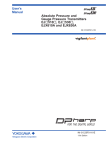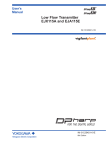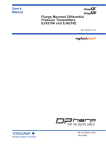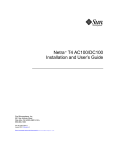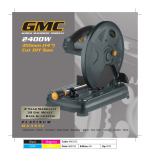Download 1090 User Manual - Time Electronics
Transcript
Time Electronics 1090 Temperature Calibrator Technical Manual V1.2 07/01/11 Time Electronics Ltd Botany Industrial Estate, Tonbridge, Kent, TN9 1RH Tel: +44(0)1732 355993 Fax: +44(0)1732 770312 Email: [email protected] Web Site: www.TimeElectronics.com 2 C ontents 1. G eneral ................................................................................................................ 3 2. F ront P anel C ontrols .......................................................................................... 4 3. Operating Ins truc tion ......................................................................................... 6 3.1. Turning the unit On/Off ...................................................................................... 6 3.2. Thermocouple Measures.................................................................................... 6 3.3. Thermocouple Source ........................................................................................ 7 3.4. RTD (PT100) Simulation Measure ...................................................................... 7 3.5. RTD (PRT) Source............................................................................................... 8 3.6. uV/mV Measure ................................................................................................... 8 3.7. uV/mV Source ..................................................................................................... 8 3.8. mA Measure ........................................................................................................ 8 3.9. mA Source and 24V Process Loop Drive .......................................................... 9 3.10. Storing and Recalling Values ............................................................................. 9 3.11. Step and Auto-Step Functions ......................................................................... 10 3.12. Inching (Increment/Decrement)........................................................................ 11 3.13. Menu Functions ................................................................................................ 11 3.14. Setting output values between 0.0 and +1.0 .................................................... 12 4. Maintenanc e ..................................................................................................... 13 4.1. Battery Life and Replacement.......................................................................... 13 4.2. Display............................................................................................................... 13 4.3. Front Panel Keypad and Connections ............................................................ 13 4.4. Fuse ................................................................................................................... 13 5. S pec ific ations ................................................................................................... 14 6. 1090 C alibration P roc edure ............................................................................. 18 7. G uarantee & S ervic ing ..................................................................................... 20 All Time Electronics' instruments are subject to continuous development and improvement and in consequence may incorporate minor detail changes from the information contained herein. 1090 Technical Manual Page |2 3 1. G eneral The 1090 is a high performance instrument designed for use in both the lab and field. It simulates and can measure from the most commonly used temperature sensors thermocouples (8 types) and PT100. In addition it can generate and measure mV and mA. Display is via a large, easy to read, 16 character LCD screen. The user interface is simple and intuitive. Increment and Decrement (Inching) keys enable the output to be stepped up or down in 0.1, 1 or 10º C steps, and 0.1,1 or 10 uV/mV/mA.. This feature is especially useful for calibrating thermostat type controllers with hysteresis. Automatic or manual cold junction compensation can be selected and applied. Up to 10 frequently used output values can be stored in the non-volatile memory. These can be re-called at any time and stepped through either manually or automatically. The 1090 is supplied in a robust case with a carrying strap. A pocket for this manual and test leads is provided. Full operation, including re-charge, is possible without removal from the case. The lid is reversible to simplify operation. The 1090 is powered by a 5000mA Ni-MH battery pack; this will give a maximum operation time of around 60 hours (depending on functions used). It is important not to over-charge the battery pack, as this could lead to a shortened life; see section 4.1, page 13. 1090 Technical Manual Page |3 4 2. F ront P anel C ontrols A B C D E P F Q R G H I J S L T U V W M N X Y K Keypad Primary and Secondary functions Most of the 1090’s keys are dual function. Their primary function is shown in blue on the lower half while the secondary function is shown in red, on the upper half. To access the secondary functions press the ‘SHIFT’ key before the required secondary function key. The display indicates when the ‘SHIFT’ key has been pressed by showing an ‘S’ on the right hand side. This mode is always cancelled after the secondary function is selected, or the ‘CLEAR’ is pressed. 1090 Technical Manual Page |4 5 Secondary functions are shown in [ ] A B C D E F G H I J K L M N P Q R S T U V W X Y 4mm Output Terminals 4mm Input Terminals Chassis earth connection 16 digit Liquid Crystal Display Increments output in accordance with user set resolution Decrements output in accordance with user set resolution [Turns unit off] [Selects Type S thermocouple] [Selects Type R thermocouple] [Selects Type K thermocouple] [Selects Type J thermocouple] [Selects Type B thermocouple] [Selects mV] [Selects mA] [Selects uV] In source mode recalls values stored in memory [Stores values in memory] Steps to the next stored value [Auto steps] [Selects Type T thermocouple] Allows menu functions to be viewed and changed [Toggles the temperature readout between oC and oF] [Selects Type N thermocouple] [Selects Source or Measure] [Selects Type E thermocouple] Clears value Enters an output value. [Selects PRT (RTD) mode] Sets keypads to secondary (RED) functions Note: The secondary keypad functions are available only when relevant to the selected operating mode eg ’Auto Step’ is not available when the 1090 is in measure mode. Also please note that the ’SHIFT’ mode has an automatic time out. This means that it will automatically be cancelled if the secondary function is not selected within a few seconds. 1090 Technical Manual Page |5 6 3. Operating Ins truc tion 3.1. Turning the unit On/Off To Turn On The unit is powered up by pressing and holding any key for longer than 1 second. On power-up, the software version and (mV/mA/Pt) will be displayed for 2 seconds. The battery voltage is then checked and if below 6.5V a ‘Battery Low’ warning is displayed. If below 6.0V a ‘Battery Dead’ warning appears and the unit powers down. The unit then goes into its default start mode, Measure mV To Turn off The unit is powered down by pressing ‘SHIFT’ followed by ‘OFF’ key. Cold Junction Temperature Compensation Automatic or Manual Cold Junction Temperature Compensation may be applied. On power up the unit defaults to Auto CJ status. To change to Manual press the ‘MENU’ key followed by the up and down arrows until the display indicates step: 3) CJ Auto xxx oC Press the ‘ENTER’ key. The unit switches to manual and is ready to accept a manual figure entered from the number keys. The unit remains in the CJ Manual mode until it is turned off. Note: Setting Cold Junction Compensation in degF requires the unit to be in degF units before entering the menu. 3.2. Thermocouple Measures When the unit is turned on it displays the software version number and then enters its default mode (mV measure) and displays Meas 0.00mV Connecting the Thermocouple Connect the thermocouple cable or compensating cable to the 1090’s input terminals. Thermocouple Selection Select the type of thermocouple that you wish to measure by pressing the SHIFT’ key immediately followed by the thermocouple type. e.g. SHIFT then J to select type J. The unit will indicate type and temperature. The display will then show: Meas Ja 23.9 oC The ‘a’ following the J indicates that the unit is set for automatic cold junction compensation. If automatic cold junction compensation is not required, it should be disabled using the menu set-up. See section 3.1. The display may be toggled to show in degF or degC by pressing ‘SHIFT’ then the ‘oC/oF’ key. Note: If required, the actual thermocouple output voltage in mV can be shown by pressing and holding down the ‘ENTER’ key. For CJC operation see 3.1 1090 Technical Manual Page |6 7 3.3. Thermocouple Source Select Source mode by pressing ‘SHIFT’ followed immediately by ‘SOURCE’ key. The display will show, Src 0.00mV Thermocouple Selection Select the type of thermocouple that you wish to simulate by pressing the SHIFT’ key immediately followed by the thermocouple type. e.g. SHIFT followed by ‘J’ to select type J. The unit will indicate type and temperature. The display will show, Src Ja xx.x oC The ‘a’ following the J indicates that the unit is set for automatic cold junction compensation. If cold junction compensation is not required see section 3.2 to enable/disable. The display may be toggled to show in oF or oC by pressing ‘SHIFT’ followed by the ‘oC/oF’ key. Note: The actual output voltage in mV can be displayed by pressing and holding down the ‘ENTER’ key. Connect the device to be calibrated to the unit’s output terminals using thermocouple or compensating cable. Temperature for a Type J T/C can now be simulated. Enter the desired output temperature using the numbered keys and press ‘ENTER’ or by using the ‘up/down’ arrow keys. Pressing the ‘ENTER’ key will momentarily display the equivalent source voltage. For CJC operation see 3.1 3.4. RTD (PT100) Simulation Measure When the unit is turned on it displays the software version number. It then enters its default mode - Millivolt (mV) and displays, Meas 0.00mV Select the PRT by pressing the SHIFT’ key immediately followed by ‘PRT’ Meas Pt Over oC [The word ‘Over’ indicates over range and is displayed when probe is not connected (Terminals open circuit). The word ‘Under’ indicating under range is displayed when terminals are short circuited]. The display may be changed to read in oF by pressing ‘SHIFT’ then the ‘oC/oF’ key. For this mode connect a PT100 sensor to the unit’s OUTPUT terminals. The unit will measure temperature. Pressing the ‘ENTER’ key will momentarily display the equivalent ohms value. 1090 Technical Manual Page |7 8 3.5. RTD (PRT) Source Select the PRT mode by pressing the SHIFT’ key immediately followed by ‘PRT’ Meas Pt Over oC Select Source mode by pressing ‘SHIFT immediately followed by ‘SOURCE’ Src Pt –100 oC The display may be changed to read in oF by pressing ‘SHIFT’ + ‘oC/oF’ keys For this mode connect the device to be calibrated to the unit’s OUTPUT terminals. The unit is now ready to simulate a Pt100 probe. Use the ‘Up/Down’ arrow keys to step change the temperature. Pressing the ‘ENTER’ key will momentarily display the equivalent ohms value. 3.6. uV/mV Measure Measuring mV Press ‘SHIFT’ followed immediately by ‘mV’ to select mV measure mode. Meas 0.00mV The unit is ready to measure mV connected at its input terminals. Measuring uV To measure uV press ‘SHIFT’ followed immediately by ‘uV’ The unit is ready to measure uV connected 3.7. uV/mV Source mV Source Select Source mode by pressing ‘SHIFT immediately followed by ‘SOURCE’ Src 0.000mV Connect the device to be calibrated to the unit’s output terminals Enter the desired mV values using the numbered keys or ‘Up/Down’ arrow keys. uV Source Select Source mode by pressing ‘SHIFT immediately followed by ‘SOURCE’ Press ‘SHIFT’ followed immediately by ‘uV’ Src 0uV Connect the device to be calibrated to the unit’s output terminals Enter the desired uV values using the numbered keys or ‘Up/Down’ arrow keys. 3.8. mA Measure To select mA Measure mode press ‘SHIFT’ followed immediately by ‘mA’. Meas 0.00mA The unit is ready to measure mA at its input terminals. 1090 Technical Manual Page |8 9 3.9. mA Source and 24V Process Loop Drive To select Source mode press ‘SHIFT’ followed immediately by ‘Source’ Scr 0.000mV To select mA Source mode press ‘SHIFT’ followed immediately by ‘mA’ Src 0.000mA Connect the device to be calibrated to the unit’s output terminals Enter the desired mA values using the numbered keys or ‘Up/Down’ arrow keys. It should be noted that the unit can provide a maximum output of 80mA. The user should be aware that continuous operation at this level will reduce the battery life considerably. 24V process loop drive It is possible to use the unit to drive conventional process loops with 24V dc and up to 60mA. Select mA Source mode as described above. Set the current output to 60mA (or less if required). The output terminals will then provide 24V (+/- 0.5V) to drive the loop. It will allow up to the set value of current to be supplied before the output voltage will drop. 3.10. Storing and Recalling Values In the source mode the 1090 unit is able to store and recall up to ten output values. The values may be stored in locations 0 to 9). The values may be recalled manually or automatically. Used in conjunction with the ‘Auto Step’ function the unit may be programmed to output the stored values in sequence pausing at each value. The pause (wait-time) is adjustable. To store values in memory first the unit has to be in the Source mode. Select the source mode by pressing ‘SHIFT’ followed immediately by ‘Source’ Src 0.000mV Select the required type of source units (Thermocouple, RTD, uV or mA). e.g. For mA press ‘SHIFT’ immediately followed by ‘mA’ **** Src 0.000mA **** Entering and storing values Select ‘SOURCE’ mode followed by the required parameter i.e. thermocouple type, uV, mV, or mA. Please note that Store/Recall is not available for PRT ( you just step through the fixed values using the up/down arrows for this parameter) 1. Enter the required value for the selected parameter followed by the ’ENTER’ key. 2. Press ‘SHIFT’ followed by ‘STORE’ the display will show, Store 0-9 > 3. Enter the required store location number, i.e. 0 - 9. Repeat steps 1 to 3 for up to a maximum of ten store locations. 1090 Technical Manual Page |9 10 Recalling values To recall the stored values the unit must be in ’SOURCE’ mode. 1. Press ‘RECALL’, the display will show, Recall 0-9 > 2. Press the required store location number, the display will show the stored value and it will be sent to the output terminals. 3. Repeat steps 1 and 2 to recall the contents of the other store locations. It should be noted that the store locations only store the numeric value, and not the units. Therefore the correct units i.e. uV, mV etc must be selected before the recall is done. 3.11. Step and Auto-Step Functions These modes provide a method of manually or automatically stepping through the stored values. When in automatic mode the unit may be programmed to dwell on the stored value for between 1 and 9 seconds before proceeding to the next one. To use the Auto/Manual Step functions the unit must be in ‘SOURCE’ mode. Manual Stepping Ensure that the unit is in ‘SOURCE’ mode and the desired units are selected. Use the ‘RECALL’ key to set the pointer to the stored locations. If you want to start at location 1, press ‘RECALL’ followed by ‘1’. This will display and output the contents of location 1. Subsequent pressing of the ‘STEP’ key will step through the store locations in order, starting with location 2. After recalling the contents of location 9 the next step will return to location 1. Note: If the ‘RECALL’ key is held in for a short while before releasing it will show the store location number being recalled Automatic Stepping Use the ‘RECALL’ key to set the pointer to the required first location. The select ‘AUTO STEP’. The display will then ask you to enter the required delay in seconds, enter a single figure between 0 and 9 followed by the ‘ENTER’ key. This will set the dwell time on each recall and automatically start the sequence. After the 9th location has been recalled the sequence will continue by rolling over back to location 1. The cycle of stepping through the locations will continue indefinitely until a key is pressed - this will terminate the cycle immediately. 1090 Technical Manual P a g e | 10 11 3.12. Inching (Increment/Decrement) The unit has a general purpose inching function. This adjusts the output in fixed increments of temperature (thermocouples only) or voltage or current. The set-up menu gives a the user a choice of three levels of increment, i.e. 0.1, 1 or 10 for degC/degF, and 1, 10, or 100 uV/uA for voltage/current. The lowest of these represents the highest setting resolution and provides the most precise control of the output. This is especially useful for calibrating thermostat controllers which have tight specification on hysteresis , or for the fine adjustment of the output level needed to give a precise indicator reading. 3.13. Menu Functions The MENU key provides access to a number of auxiliary features. Press ‘MENU’ and hold , Ent, Menu Power Auto-off This refers to auto power down state. To conserve battery life the unit will switch off after 5 minutes if set to ‘on’. On releasing the ‘MENU’ 1) Auto-off Yes To disable this function press ‘ENTER’ whilst the display is showing. Beep On/Off This turns on/off the bleep sounder when a key is pressed. Press ‘MENU’ and release 1) Auto-off Yes Use down arrow key to display 2) Beep On. To turn it off press ‘ENTER’ Cold Junction Compensation Auto/Man Press ‘MENU’ and release 1) Auto-off Yes Use down arrow key to display 3) CJ Aut. xx.x oC. To change to manual operation press ’ENTER’ Man CJ _ _ _ _ _ _ _ oC Enter a degree value using the number keys and press ‘ENTER’ The unit reverts to Auto when next switched on 1090 Technical Manual P a g e | 11 12 Inching (Incrementing/Decrementing) - arrow keys This function sets the step size used by the Up/Down arrow keys. Press ‘MENU’ and release 1) Auto-off Yes Use down arrow key to display 4) xx.x o, xxxu Press ‘ENTER’ to cycle between the 3 available settings (0.1, 1.0, or 10 oC ; 1,10 or 100uV/uA) Battery status Displays battery voltage Press ‘MENU’ and release 1) Auto-off Yes Use down arrow key to display 5) Battery x.xxV 3.14. Setting output values between 0.0 and +1.0 It is important that a leading zero is keyed in when setting output positive values between 0.0 and +1.0 The negative sign/decimal point key has a dual function of ‘-’ and ‘.’ When entering a value, if this key is the first one pressed a negative value will be entered. If it is not the first key pressed it will enter a decimal point. Therefore a leading zero must be entered if a positive value of between 0.0 and 1.0 is required, eg 0.75. However, this is not the case for settings between 0 and –1.0, where it is allowable to enter just -.75, and a leading zero is not required. 1090 Technical Manual P a g e | 12 13 4. Maintenanc e 4.1. Battery Life and Replacement The 1090 is powered from an internal metal hydride battery pack with a capacity of 5AH. This provides up to 60 hours of continuous operation. The mains recharger will recharge the battery fully in about 11 hours. During operation the battery voltage level is checked once per minute. If below 6.5V, a ‘Battery Low’ warning is displayed. If below 6.0V, a ‘Battery Dead’ warning appears and the unit powers down. 4.2. Display The LCD display should not be exposed to strong sunlight for prolonged periods. 4.3. Front Panel Keypad and Connections Front panel is a sealed membrane keypad. It should be cleaned by wiping with a damp cloth. Solvents must not be used to clean the keypad as damage may result. 4.4. Fuse A 0.5A slow blow battery supply fuse is located on the main board. Size (20mm / 0.78in x 5mm / 0.20in dia) 1090 Technical Manual P a g e | 13 14 5. S pec ific ations MEASURE ACCURACY (0.1 deg C/F resolution) THERMOCOUPLE TEMPERATURE ACCURACY TYPE RANGE deg C Deg C J -200 to 580 0.7 K -200 to –150 2.5 -150 to 750 0.5 -200 to 0 1.5 0 to 400 0.4 -50 to 400 3.0 400 to 1750 1.5 -50 to 100 3.0 100 to 1750 1.5 110 to 1000 3.5 1000 to 1800 1.5 N -100 to 890 0.6 E -50 to 400 0.4 T R S B 1090 Technical Manual P a g e | 14 15 SIMULATE ACCURACY (0.1 deg C/F resolution) THERMOCOUPLE TEMPERATURE ACCURACY TYPE RANGE deg C Deg C J -210 to 150 0.15 150 to 1200 0.3 -270 to 190 0.5 190 to 1250 0.4 -200 to 150 0.4 150 to 400 0.5 -50 to 800 0.8 800 to 1750 2.0 -50 to 850 0.9 850 to 1750 2.0 100 to 1200 2.0 1200 to 1800 3.0 -270 to 260 0.5 260 to 1300 1.0 -50 to 1000 0.3 K T R S B N E An additional correction representing the equivalent 1µV should be allowed for stray thermal emf effects. Millivolt Measure 0 to +/- 30mV Resolution: 10µVAccuracy: ± 0.05% of f.s. ± 1 digit Input resistance 100K Ohms Milliamp Measure 0 to +/- 60mA Resolution 20µA Accuracy ± 0.05% of f.s. ± 1 digit Input resistance 0.5 ohms 1090 Technical Manual P a g e | 15 16 Millivolt Source 0 to +/- 80mV Accuracy 0.02% of f.s. (16uV) Resolution 5uV Output resistance 10 ohm Note: For output settings below 8mV an increased resolution of 0.5uV is automatically switched in. The accuracy for this part of the span is also increased to +/- 4uV Milliamp Source 0 to 80mA Accuracy 0.02% of f.s. (16uA) Resolution 5uA Maximum load (24V drive) 300R/80mA, 480R/50mA, 1.2K/20mA Inching Three levels of increment, 0.1, 1 or 10 for degC/degF, and 1, 10 or 100 uV/uA for voltage current. The lowest of these represents the highest setting resolution and provides the most precise control of the output. 24V process loop drive mode A process loop can be driven at 24V up to 60mA by selecting the Milliamp source mode and setting it at 60mA (or a lower level if required). PT100 SIMULATION 14 set temperatures. Specification within ± 0.1% of DIN 43760 resistance values on all settings. Reading deg C -100.0 -50.0 -20.0 0.0 20.0 50.0 100.0 200.0 Accuracy deg C 0.3 0.3 0.3 0.3 0.3 0.3 0.3 0.5 Reading deg C 300.0 400.0 500.0 600.0 700.0 800.0 Accuracy deg C 0.5 0.5 0.5 0.7 0.7 0.7 PT100 MEASURE (0.2 degC or degF resolution) 0 to 300.0 ohms, 2 wire. Reading deg C -100.0 -50.0 0.0 100.0 150.0 200.0 250.0 300.0 Accuracy deg C 0.8 0.8 0.7 0.7 0.7 0.7 1.0 1.0 1090 Technical Manual P a g e | 16 17 General Specifications Cold Junction Compensation Resolution: 0.1degC or 0.2degF. Accuracy: 0.1degC/0.2degF at 22degC/72degF. Variation with change in ambient: +/- 0.02 degC/F per degC/F Operating Temperature -10 to 40 degC (15 to 105 degF) Connections 4 off 4mm low thermal screw terminals. Power The internal metal hydride battery pack gives approximately 60 hours continuous operation. The mains re-charger supplied allows full recharge about 11 hours. To conserve battery life a user inactivity automatic power down feature is included. Dimensions 235 x 150 x 75 mm 1.25 Kg 1090 Technical Manual (9.25 x 6 x 3 ins 2.8lb) P a g e | 17 18 6. 1090 C alibration P roc edure Calibration MENU 6 ENTER, enters calibration mode The unit prompts for a password to enter cal mode The code is 982053. There are 8 calibration steps, as follows Pressing CLEAR at any step will skip that step, leaving the calibration data for that step unchanged. Power must not be removed during the calibration process, as this will cause the data check sum to be incorrect. 1) Input +30mV Apply +30.000mV to the input terminals. PRESS ENTER. 1) Input -30mV Apply -30.000mV to the input terminals. PRESS ENTER 2) Src +80.00mV Measure the output voltage. Use the up/down keys to adjust for an output of 80.000mV output. For coarse the keys immediately below the arrow keys can be used : 7/8 adjust down and up in 10 times larger units, 4/5, 100 times When the unit is first calibrated after manufacture, the cal factor may be a long way out. To avoid lots of key pressing, pressing SHIFT will set it to a value close to the nominal calibration value. 3) Src +8.0mV As above, adjust for +8.000mV 4) Src - 80.0mV As above, adjust for -80.000mV 5) Src -8.0mV As above, adjust for -8.000mV 6) Temp Display current calibrated temperature. If incorrect, press ENTER and enter the current temperature at the CJ sense point in degrees C. 7) Pt100 Only perform this task if the mA/pt100 board is fitted. Connect a 300.0ohm precision resistor across the output terminals Press ENTER. the unit will then restart. 1090 Technical Manual P a g e | 18 19 If the PRT/Current board is fitted and requires calibration, this must be done after the voltage steps 1-6 above have been performed P50 calibrates the current measure mode, and P51 current source mode. These should be adjusted at full-scale (30mA measure, 80mA source). If the PRT/Current board is recalibrated, you must repeat step 8 above afterwards (use CLEAR to skip past the other steps). Notes on the PRT/Current option board. The PRT/Current board has calibration adjustments on-board for current source and measure and can be supplied ready-calibrated for retrofitting in the field. When a 1090 unit is initially factory calibrated, it is necessary to fit a calibrated PRT/Current option board so that step 8 can be completed (this calibrates for the initial accuracy of the on-board voltage reference). 1090 Technical Manual P a g e | 19 20 7. G uarantee & S ervic ing Guarantee Period This unit is guaranteed against defects in materials and workmanship for a period of one year from its delivery to the customer. We maintain comprehensive after sales facilities and the unit can, if necessary be returned to us for servicing. During this period, Time Electronics Ltd will, at its discretion, repair or replace the defective items. For servicing under guarantee, the instrument type and serial number must always be quoted, together with details of any fault and the service required. The purchaser of the instrument must prepay all shipping charges. Time Electronics Ltd will pay return shipping charges. This guarantee is void if servicing has been attempted by an unauthorised person or agent. If, during the guarantee period, failure is due to misuse or abuse of the unit, the repair will be put in hand without delay and charged unless other instructions are received. Please note that if you require a new UKAS Certificate during the warranty period, this will be charged at the current rate on our price list. Service After Guarantee Period Even after the guarantee period has expired, Time Electronics Ltd., can still service your instrument. As the manufacturer, we have the specialised knowledge needed to keep your instrument in peak condition and we also maintain a comprehensive spare parts service. Please enclose details of the service required and your full company details including a contact name when returning for servicing. Returning Instruments When returning instruments, please ensure that they have been adequately packed, preferably in the original packing supplied. Time Electronics Ltd will not accept responsibility for units returned damaged. Please ensure that all units have details of the service required and all relevant paperwork. Send the instrument, shipping charges paid to:- Time Electronics Ltd Botany Industrial Estate, Tonbridge, Kent, TN9 1RH Tel: +44(0)1732 355993 Fax: +44(0)1732 770312 Email: [email protected] Web Site: www.TimeElectronics.com Disposal of your old equipment 1. When this crossed-out wheeled bin symbol is attached to a product it means the product is covered by the European Directive 2002/96/EC. 2. All electrical and electronic products should be disposed of separately from the municipal waste stream via designated collection facilities appointed by the government or the local authorities. 3. The correct disposal of your old appliance will help prevent potential negative consequences for the environment and human health. 4. For more detailed information about disposal of your old appliance, please contact your city office, waste disposal service or return to Time Electronics. 1090 Technical Manual P a g e | 20




















